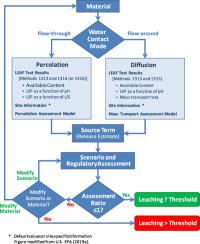Journal of Hazardous Materials ( IF 13.6 ) Pub Date : 2020-11-20 , DOI: 10.1016/j.jhazmat.2020.124635 Andrew C Garrabrants 1 , David S Kosson 1 , Kevin G Brown 1 , Daniel P Fagnant 2 , Gregory Helms 2 , Susan A Thorneloe 3

|
A methodology for developing scenario-based leaching assessments as part of the Leaching Environmental Assessment Framework (LEAF) is illustrated using a hypothetical management/treatment scenario of contaminated soil from a copper and lead smelter. Scenario assessments refine the process beyond screening-level assessments by considering site- and scenario-specific information about the disposal or utilization environment. LEAF assessments assume (i) granular materials leach at local equilibrium with percolating water, while (ii) monolithic materials (e.g., low permeability solidified/stabilized soils) leach by diffusion-based mass transport toward surrounding contact water. Leaching concentrations, estimated using LEAF leaching test data and estimated or measured scenario information, are compared to threshold values. Demonstration results indicate that leaching from untreated soil is significantly (>10x) greater from solidified/stabilized soil than treated material, except for highly soluble constituents (Cl-, NO3−2) or when constituents have similar equilibrium concentrations in both materials (As, Pb). Comparison between wet and dry environments show that while dry environments lead to lower COPC mass-based rates of leaching, the leaching concentrations may be higher due to lower liquid-to-solid ratios. The presented assessment methodology can be used to evaluate treatment effectiveness when both physical and chemical retention characteristics of the material are altered.
中文翻译:

使用浸出环境评估框架 (LEAF) 进行情景评估和处理效果演示的方法
作为浸出环境评估框架 (LEAF) 的一部分,开发基于场景的浸出评估的方法通过铜铅冶炼厂污染土壤的假设管理/处理场景进行说明。情景评估通过考虑有关处置或利用环境的特定地点和情景信息,完善筛选级评估之外的流程。LEAF 评估假设 (i) 粒状材料与渗滤水处于局部平衡状态下浸出,而 (ii) 整体材料(例如低渗透性固化/稳定土壤)通过基于扩散的传质向周围接触水浸出。使用 LEAF 浸出测试数据和估计或测量的情景信息估计的浸出浓度与阈值进行比较。示范结果表明,除了高度可溶性成分(Cl -、NO 3 -2)或成分在两种材料中具有相似的平衡浓度(As ,铅)。潮湿和干燥环境之间的比较表明,虽然干燥环境导致 COPC 基于质量的浸出率较低,但由于液固比较低,浸出浓度可能较高。当材料的物理和化学保留特性改变时,所提出的评估方法可用于评估处理效果。



























 京公网安备 11010802027423号
京公网安备 11010802027423号